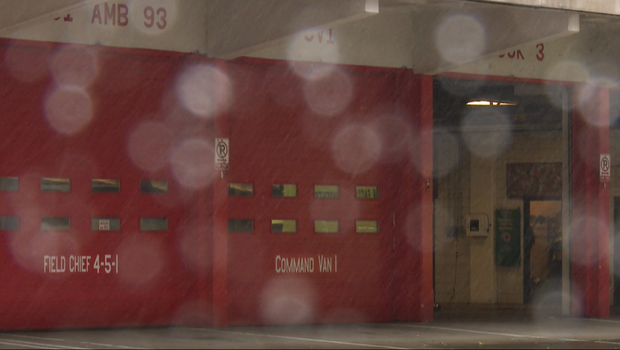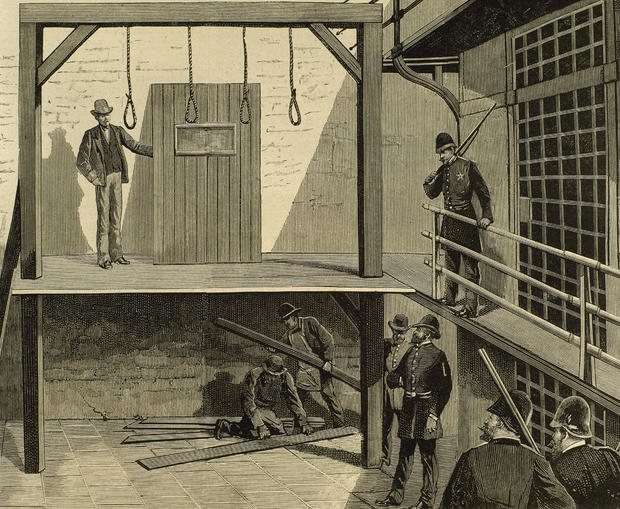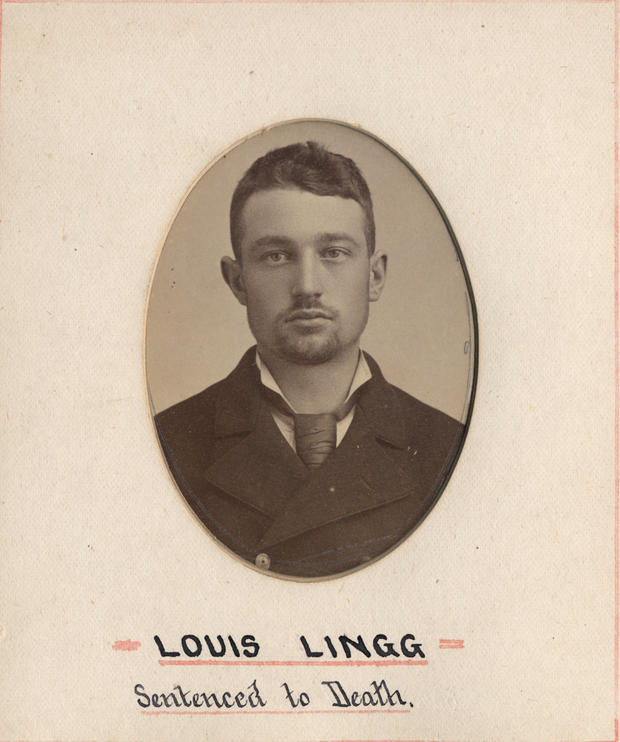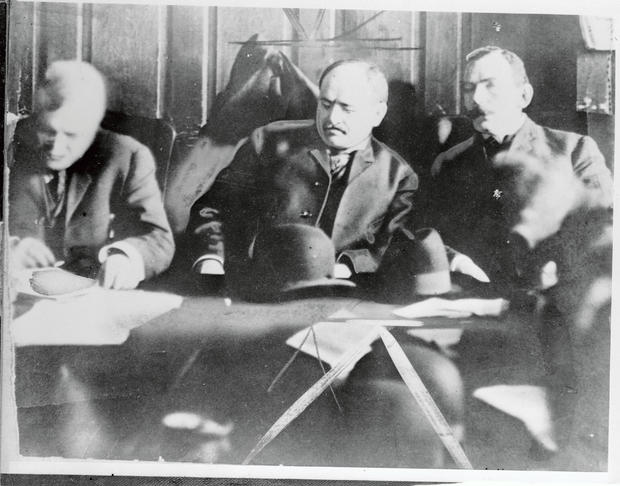Chicago Hauntings: The Sinister Men Who Were Executed At The Old Cook County Jail Gallows, And Sightings At The River North Firehouse Now In Its Place
CHICAGO (CBS) -- At the southwest corner of Illinois and Dearborn streets, you will currently find the Engine Co. 42 firehouse – which has stood there since 1968. Plans were announced a few years ago to have the brutalist firehouse torn down for a new 30-story office tower called the Rivere – which will also incorporate a new firehouse, according to multiple published reports.
But this story isn't about that. It's about what used to stand where the firehouse stands today.
Before the Cook County Jail moved to its current location in the Little Village community, it was located at that very site at Illinois and Dearborn streets. To this day, the former Cook County Criminal Courthouse stands just to the south facing Hubbard Street – the Romanesque structure is now known as Court House Place and houses offices.
On the Illinois Street side – around the middle of the present-day firehouse – was the site where at least 90 men were executed by hanging, Tony Szabelski of Chicago Hauntings Ghost Tours tells us. Hangings were legal in Illinois until 1928. No women were ever hanged in Chicago – only men.
There are many stories of the fire station that now occupies the site being haunted, Szabelski pointed out. Firefighters for years have reported the sound of a moaning or a wailing ghost.
Among those who were hanged at the old Cook County Jail site were four defendants from the Haymarket Affair – a labor protest that turned violent and is the subject of strong feelings to this day.
On Saturday, May 1, 1886, 80,000 workers marched down Michigan Avenue demanding an eight-hour workday with no loopholes or cuts in pay. Similar rallies were held in other cities across the country.
The Chicago rally picked up more and more participants as it picked up participants on May 3 and 4. They clashed with police several times, and on May 3 at the McCormick Reaper Plant, two demonstrators were shot and killed by police who allegedly fired into the crowd.
The following day, a crowd gathered at Haymarket Square, at Des Plaines and Randolph streets. The gathering was initially peaceful, but as the crowd dwindled, someone threw a bomb at the police officers who had gathered at the scene, leaving eight officers dead and 60 injured. Police opened fire afterward, and chaos erupted.
It was never learned exactly who threw the bomb, but outrage erupted across the city and the nation. Newspapers editorialized about an anarchist conspiracy theory, and police took hundreds of people into custody. Thirty-one people were indicted, and eight stood trial – George Engel, Samuel Fielden, Adolph Fischer, Louis Lingg, Oscar Neebe, Albert Parsons, Michael Schwab, and August Spies. All were anarchist labor activists.
The trial was widely criticized for being conducted without any evidence that the defendants were involved in the bomb throwing or in planning it, or even that there was any conspiracy among anarchists to attack police.
Nonetheless, all eight defendants were convicted, and seven were sentenced to death. Engel, Fischer, Parsons and Spies were all executed at Cook County Jail – the one at Dearborn and Illinois streets – while Lingg committed suicide. The others were imprisoned, until Gov. John Peter Altgeld pardoned them in 1893.
The story is that Lingg committed suicide in his jail cell by putting a blasting cap in his mouth and lighting it. Legend has it that he was left severely disfigured, but survived another six hours during which he wrote, "Hoch die anarchie!" – German for, "Hurrah for anarchy!" in his own blood on the stone of his cell before he died.
Some say Lingg is the one whose ghost is heard wailing in the firehouse.
Also executed at the old jail was Chicago serial killer Johann Otto Hoch – also known as the Bluebeard Murderer, after the French folktale about a wealthy nobleman who has lured a succession of women into marriage and gone on to murder them. Johann Hoch was not the Chicago killer's real name – most sources say his real name was John or Johann Schmidt or possibly Jacob Schmidt, and he used an assortment of aliases as he ensnared lonely widows and spinsters into a succession of marriages, took their money, and in many instances murdered them.
Hoch came to the U.S. from Germany and eventually found his way Chicago in 1895. A 1964 American Heritage Magazine article by A.I. Schutzer claims Hoch married a total of between 43 and 50 women – Szabelski reports it may have been 55. The marriages were always short, as Hoch took the women's money and either ran or killed them by poisoning with arsenic.
Hoch eventually ended up getting into trouble in connection with his marriage to a woman named Marie Walcker, a widow who owned a candy store at Willow and Larrabee streets in Lincoln Park, according to the book "Speaking Ill of the Dead: Jerks in Chicago History" by Adam Selzer and William Griffith. Hoch and Walcker wed in what the book described being openly little more than a business transaction in December 1904, and Hoch ordered Walcker to sell the candy store and took her life savings. Soon afterward, Walcker became sick and died in January 1905, reports say.
Days later, Hoch married Walcker's sister – identified in most accounts as Emilie Fischer of Joliet. But upon learning some of Walcker's friends believed she had been poisoned, Hoch fled, already having taken Fischer's money, Selzer and Griffith's book says. Meanwhile, the book and other sources say, Walcker's body was exhumed and arsenic was found – and Hoch became a wanted man.
Hoch found his way to New York. Using the name Henry Bartel, he proposed to Catherine Kimmerle, who ran the boarding house in Manhattan's Hell's Kitchen section where he was staying, according to a contemporary newspaper report from the Baltimore Sun. She refused his proposal and went to police – suspecting her suitor to be Hoch, by then the subject of a manhunt.
Hoch was extradited back to Chicago and was convicted of Walcker's murder in 1905. He was hanged at the old County Jail gallows in February 1906, and Szabelski reports his ghost was reported seen there shortly after the execution.
Also reported by firefighters at the present-day firehouse are what appear to be sounds of somebody singing throughout the building, Szabelski tells us. Several men actually sang as they were brought to the gallows, but the most famous was a murderer named Carl Wanderer, whose case became known as "The Case of the Ragged Stranger."
Wanderer had been a lieutenant in the U.S. Army in World War I and claimed to be highly decorated, reports say. He also owned a successful butcher shop in Chicago, Szabelski reports.
In 1919, Wanderer married a 20-year-old woman named Ruth Johnson and moved into an apartment they shared with her parents, according to the book "Murder & Mayhem on Chicago's North Side" by Troy Taylor. The book said Wanderer had already lost his affection for his wife – and was already dating a 16-year-old named Julia Schmitt – when his wife found out his wife was pregnant.
So one day in 1920, as Szabelski and other sources tell it, Wanderer walked up to a drifter on the old Madison Street Skid Row on the Near West Side. Wanderer told the drifter his wife did not think he was enough of a man and he wanted to prove to her otherwise – and offered the drifter $10 to jump out from behind the bushes and pretend to rob Wanderer and his wife as they returned from the movies. Wanderer proposed he would fight back, and look like more of a man to his wife, Szabelski recounted.
The drifter agreed to the plan, and Wanderer even provided him with a gun. But things did not end up going the way Wanderer had initially proposed.
As Wanderer and his wife walked home from what multiple reports say was the Pershing Theater in Lincoln Square – which we now know as the Davis Theater at 4614 N. Lincoln Ave. – the drifter pretended to ambush them with a gun and waited for Wanderer to throw a punch. But Wanderer instead shot and killed the drifter – and his own wife. According to Taylor's book, this happened in the vestibule of the building where they lived.
Wanderer first claimed that the drifter had shot and killed his wife and he had fired back in self-defense, and he was initially regarded as a hero to the public. But detectives began wondering why a drifter who had no money in his pocket had such a nice, expensive gun – and when they ran the serial numbers on the two guns involved that night, they were only a couple of numbers off, Szabelski reported. The serial number of the gun the drifter purportedly used was traced back to Carl's cousin, Fred Wanderer.
Carl Wanderer initially told investigators he had been carrying two guns and the drifter snatched one of them from him, but detectives wondered what could possibly have made Wanderer believe he needed two guns while just walking home from the movies. He eventually confessed and was hanged at the County Jail gallows in 1921.
As to the relevance of the singing ghost at the present-day firehouse, reports say Wanderer was singing at the gallows before he was about to be hanged. While many accounts identify the song as "Dear Old Pal of Mine," Selzer identifies it as "Old Pal, Why Don't You Answer Me?"
Szabelski's favorite story about the old County Jail gallows is not about the hangings that actually happened, but of one that did not. In 1921, a gangster named "Terrible" Tommy O'Connor was arrested for the murder of Chicago Police Sgt. Patrick O'Neill. O'Connor was tried and convicted, and was scheduled to be executed at the gallows in December 1921.
But just a few nights before the execution was to take place, O'Connor and a couple of other men knocked over a jail guard and took the guard's gun, and scaled a prison wall reported by the Chicago Tribune to be 20 feet high. They jumped out onto Illinois Street, and O'Connor jumped onto the running board of a passing car – ordering the driver to keep going, Szabelski reported.
O'Connor worked his way through the Near North Side – commandeering a succession of cars as the first driver killed his engine and the second crashed, according to contemporary reports. Eventually, a driver crashed in an alley and O'Connor ran off. That was the last time O'Connor was ever seen alive again.
Hangings were abolished in Chicago in 1928 – the method was switched to electrocution, and the Cook County Jail maintained an electric chair at its current location at 2700 S. California Ave. until 1962. But a judge did rule that because O'Connor had been sentenced to execution by hanging, the gallows had to be maintained in case he was found, Szabelski tells us.
It was not until 1977 that another judge concluded that O'Connor was not likely to reemerge and it was time to destroy the old gallows – which had been sitting in the basement of the present-day Criminal Courts Building, Szabelski reported. But the Chicago Tribune reported that before that happened, a buyer bought the remains of the gallows platform and turned it over to a museum in Union, Illinois.
Video produced by Blake Tyson. Written story by Adam Harrington.









